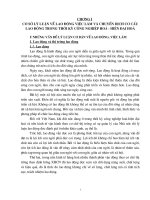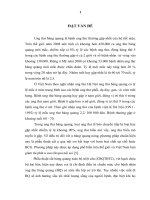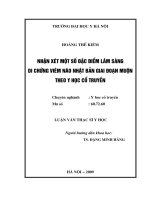Nhận xét một số điểm khác biệt giữa nhóm thai phụ chẩn đoán ĐTĐ rõ lần đầu phát hiện trong thời kỳ mang thai và nhóm ĐTĐ thai kỳ_Tiếng Anh
Bạn đang xem bản rút gọn của tài liệu. Xem và tải ngay bản đầy đủ của tài liệu tại đây (610.4 KB, 27 trang )
<span class='text_page_counter'>(1)</span><div class='page_container' data-page=1></div>
<span class='text_page_counter'>(2)</span><div class='page_container' data-page=2>
<b>INTRODUCTION </b>
GDM is rapid rising worldwide, especially in the Asia
region.
The prevalence of GDM varies from 8,9 – 53,4%:
New criteria by the IADPSG on diagnosis of GDM
Increment in the prevalence of obesity and T2DM in young women.
</div>
<span class='text_page_counter'>(3)</span><div class='page_container' data-page=3>
<b>INTRODUCTION </b>
The HAPO study showed a positive correlation between
maternal hyperglycemia level and adverse maternal, fetal,
and/or neonatal outcomes.
Higher levels of maternal glucose with no defined levels,
after which the risk increases.
</div>
<span class='text_page_counter'>(4)</span><div class='page_container' data-page=4>
<b>INTRODUCTION </b>
The IADPSG proposed the following definition for overt
diabetes during pregnancy (ODM): pregnant women who meet
the criteria for diabetes in the nonpregnant state but were not
previously diagnosed with diabetes.
Women with ODMP are newly defined as having:
Fasting glucose ≥ 7,0 mmol/l
or 2h post OGTT glucose ≥ 11,1 mmol/l
</div>
<span class='text_page_counter'>(5)</span><div class='page_container' data-page=5>
INTRODUCTION
• Thus, 2 types of glucose intolerance are identified in
pregnancy: GDM and ODM.
• Our hypothesis is that ODM would have a more severe
glycemic disturbance and increased risk of both maternal
and neonatal complications.
• However, little has been reported regarding differences
in pregnancy outcomes between these groups.
</div>
<span class='text_page_counter'>(6)</span><div class='page_container' data-page=6>
<b>Patients and methods </b>
• Patients and methods: The study conducted from 11/2014 to 7/2015
in Endocrinology - Bach Mai Hospital. Data were collected on 283
women in the study including 104 with overt diabetes and 179
women with gestational diabetes. These women were examined,
managed blood glucose by modifying lifestyles and dietor insulin
treatment until the end of pregnancy
</div>
<span class='text_page_counter'>(7)</span><div class='page_container' data-page=7>
<b>Patients and methods</b>
Choose 2 group for study:
GDM: (ADA 2011) 75 g OGTT at 24–28 weeks gestation
Fasting glucose: ≥ 5,1 mmol/l
1h post OGTT glucose: ≥ 10,0 mmol/l
2h post OGTT glucose: ≥ 8,5 mmol/l
ODM: (ADA 2011)
Fasting glucose ≥ 7,0 mmol/l
</div>
<span class='text_page_counter'>(8)</span><div class='page_container' data-page=8>
<b>Patients and methods </b>
<b>We excluded from the study: </b>
Women with multiple fetal gestations, pre-gestational
diabetes, history of previous treatment for gestational
diabetes, active chronic systemic disease other than
chronic hypertension, women with the second of 2
</div>
<span class='text_page_counter'>(9)</span><div class='page_container' data-page=9>
<b>Patients and methods </b>
<b>Question: </b>
Age (yrs).
BMI before pregnancy (kg/m2).
Gestational weight gain (kg).
Gestational age at diagnosis (wk).
</div>
<span class='text_page_counter'>(10)</span><div class='page_container' data-page=10>
<b>Patients and methods </b>
Exam:
Blood pressure:
BMI
Sub – clinical:
75 g OGTT at 24–28 weeks gestation.
HbA1C.
</div>
<span class='text_page_counter'>(11)</span><div class='page_container' data-page=11>
<b>Patients and methods </b>
TREATMENT:
Insulin therapy
Max insulin dose.
Treatment goals (ADA 2011)
Fasting glucose : ≤ 5,3 mmol/l.
</div>
<span class='text_page_counter'>(12)</span><div class='page_container' data-page=12>
<b>Patients and methods</b>
Adverse pregnancy outcomes:
•
<b><sub>Polyhydramnios </sub></b>
•
<b><sub>Preterm birth </sub></b>
•
<b><sub>Hypertension </sub></b>
</div>
<span class='text_page_counter'>(13)</span><div class='page_container' data-page=13>
<b>Patients and methods</b>
Adverse pregnancy outcomes
• Large-for-gestational age
• Small-for-gestational age
• Hypoglycemia
• Apgar
</div>
<span class='text_page_counter'>(14)</span><div class='page_container' data-page=14>
<b>ODM </b>
<b>( n = 104) </b>
<b>GDM </b>
<b>( n = 179) </b>
<b>p </b>
Age (y) 31.5 ± 4.3 30.3 ± 5.8 p > 0.05
BMI (kg/m2) <b>22.6 ± 3.2</b> <b>20.8 ± 5.8</b> <b>p < 0,05</b>
<i><b>Baseline characteristics </b></i>
<i>Tuổi: Wong, Sugiyama khơng khác biệt. Sumin có khác biệt. </i>
<i>BMI: Khác biệt Wong, Sugiyama, Sumin. </i>
</div>
<span class='text_page_counter'>(15)</span><div class='page_container' data-page=15>
<b>Results and discussion </b>
<b>ODM </b>
<b>n = 104 </b>
<b>GDM </b>
<b>n = 179 </b>
<b>p </b>
Gestational age at diagnosis (wk) 27.4 ± 6.4 26.1 ± 1.9 p > 0.05
Gestational weight gain (kg) 10.1 ± 4.6 11.2 ± 3.5 p > 0.05
</div>
<span class='text_page_counter'>(16)</span><div class='page_container' data-page=16>
Results and discussion
<b> </b> <b>ODM </b>
<b>n = 104 </b>
<b>GDM </b>
<b>n = 179 </b> <b>p </b>
Yes – n (%) 76 (73,1 %) 50 (27,9 %) <b>p < 0.01</b>
No – n (%) 28 (26,9 %) 129 (72,1 %)
</div>
<span class='text_page_counter'>(17)</span><div class='page_container' data-page=17>
0
5
10
15
20
25
30
35
40
Family history of
diabetes
BMI ≥ 23 A history of
delivering big
baby
Glucosuria Past history of
GDM
Glucose tolerance
disorder
40
34
21 <sub>20 </sub>
10
6
14
24
8
2 4
1
ODM
GDM
<b>p < 0.01 </b>
<b>Số thai phụ</b>
<b>Results and discussion </b>
</div>
<span class='text_page_counter'>(18)</span><div class='page_container' data-page=18>
<b>Results and discussion </b>
<b>Đặc điểm </b> <b>ODM </b>
<b>n = 104 </b>
<b>GDM </b>
<b>n = 179 </b>
<b>p </b>
Antenatal oral glucose tolerance
test (fasting result) (mmol/l) 7.4 ± 2.6 5.1 ± 0.4 p< 0.001
Antenatal oral glucose tolerance
test (2-h result) (mmol/l) 13.4 ± 2.1 9.2 ± 2.8 p< 0.001
HbA1C (%) 6,6 ± 1,2 5.2 ± 0.3 p< 0.01
Ceton urinary 18(17.3%) 0
</div>
<span class='text_page_counter'>(19)</span><div class='page_container' data-page=19>
<b>Results and discussion</b>
0%
10%
20%
30%
40%
50%
60%
70%
80%
90%
100%
ODM GDM
77.9%
6.7%
22.1%
93.3%
Insulin therapy
Insulin therapy – no
<b>Insulin therapy </b>
</div>
<span class='text_page_counter'>(20)</span><div class='page_container' data-page=20>
Results and discussion
<b> </b> <b>ODM </b>
<b>n = 104 </b>
<b>GDM </b>
<b>n = 179 </b> <b>p </b> <b>RR </b>
<b>Reach treatment goals </b>
<b>n = 231</b>
<b>76</b>
<b>73.1 %</b>
<b>155</b>
<b>86.6 %</b>
<b>p < 0.01</b>
<b>2.4</b>
<b>(1.3 – 4.4)</b>
<b>No reach treatment goals </b>
n = 52
28
26.9 %
24
13.4 %
</div>
<span class='text_page_counter'>(21)</span><div class='page_container' data-page=21>
<b>Results and discussion </b>
<b> </b> <b>ODM </b>
<b>n = 86 </b>
<b>GDM </b>
<b>n = 179 </b> <b>p </b>
Gestational age at delivery (wk) 38.2 ± 1.6 39.0 ± 1.3 p < 0.01
Birth weight (g) 3.3 ± 0.6 3.2 ± 0.5 p > 0.05
Cesarean section – n (%) 66 (76.7%) 114 (80.4%) p > 0.05
</div>
<span class='text_page_counter'>(22)</span><div class='page_container' data-page=22>
<b>ODM </b>
<b>n = 86 </b>
<b>GDM </b>
<b>n = 179 </b>
<b>p </b> <b>RR </b>
<b>95% CI </b>
Yes - n 51 58 < 0.001 1.8
(1.4 – 2.4)
% 59.3% 32.4%
<i><b>Adverse pregnancy outcomes </b></i>
</div>
<span class='text_page_counter'>(23)</span><div class='page_container' data-page=23>
<b>ODM </b>
<b>n = 86 </b>
<b>GDM </b>
<b>n = 179 </b>
<b>p </b>
<b>RR </b>
<b>95% CI </b>
Polyhydramnios 19 (22.1) 23( 12.8) > 0.05 1.7 (0.9 – 2.8)
<b>Preterm birth</b> <b>22 ( 25.6)</b> <b>18 (10.1)</b> <b> < 0.01</b> <b>2.5 (1.4 – 4.5)</b>
<b>Hypertension – n (%)</b> <b>11 ( 12.8)</b> <b>5 ( 2.8)</b> <b> < 0.01</b> <b>4.6 (1.6 – 12.7)</b>
Pre-eclampsia and
Eclampsia
6 (7.0) 1 (0.6) < 0.05 -
Stillbirth 1(1.2) 1(0.6) - -
<i><b>Maternal complications </b></i>
<b>Results and discussion </b>
</div>
<span class='text_page_counter'>(24)</span><div class='page_container' data-page=24>
<b>ODM </b>
<b>n = 86 </b>
<b>GDM </b>
<b>n = 179 </b> <b>p </b>
<b>RR </b>
<b>95% CI </b>
LGA – n (%)* 10 (11.6) 10(5.6) p > 0.05 2.1 (0.9 – 4.8)
SGA – n (%)** 9 (10.5) 10 (5.6) p > 0.05 1.9 (0.8 - 4.4)
<b>Hypoglycemia – n (%)</b> <b>5 (5.8)</b> <b>2 ( 1.1)</b> <b>p < 0.05</b> <b>5.2 (1.0 - 25.2)</b>
Congenital
malformations – n (%)
4 (4.7) 1 (0.6) p > 0.05 -
Neonatal death 1(1.2) 0 - -
RDS – n (%)*** 1(1.2) 0 - -
<i><b>Neonatal complications. </b></i>
<i>Sugiyama khơng khác biệt tỉ lệ HĐHSS. Wong có sự khác biệt tỉ lệ HĐHSS. </i>
<b>Results and discussion </b>
</div>
<span class='text_page_counter'>(25)</span><div class='page_container' data-page=25>
Conclusions
• Most of the women in the groups overt diabetes have high risk
factors (73,1%).
• GDM just control blood glucose with diet (93.3%). 77.9% of
ODM group need insulin to control blood glucose.
• ODM have rate of complications for mother and fetus is higher
than GDM (59.3% versus 32.45%, p <0.01)
</div>
<span class='text_page_counter'>(26)</span><div class='page_container' data-page=26>
Recommendation
</div>
<span class='text_page_counter'>(27)</span><div class='page_container' data-page=27></div>
<!--links-->









